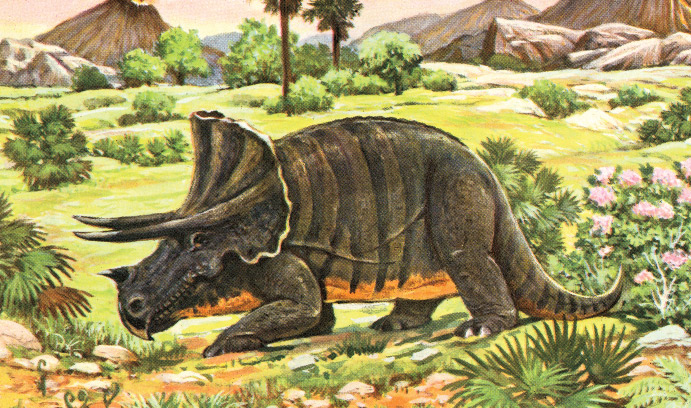The Art of Paleo-Engineering

Brandon Krick inspires new engineering techniques with a 3-D wear model developed for a study of Triceratops teeth.
The three-horned dinosaur called the Triceratops might have been more complex than we thought. In fact, Triceratops’ teeth were far more intricate than those of any reptile or mammal living today.
Brandon Krick, assistant professor of mechanical engineering and mechanics at Lehigh, and Gregory Erickson, professor of anatomy and vertebrate paleobiology at Florida State University, joined a multi-university team of engineers and paleontologists to determine that the Triceratops developed teeth that could finely slice through dense material, giving them a richer and more varied diet than modern-day reptiles.
The team outlined the findings of their NSF-funded study in the journal Science Advances.

Today, reptilian teeth are constructed to be used mostly for seizing food and then crushing it. The teeth do not occlude, or come together, like those of mammals. In essence, they can’t chew. The teeth of most herbivorous mammals self wear with use to create complex file surfaces for mincing plants.
Several years ago, Erickson suspected dinosaurs’ teeth had some unique properties, but the technology to really discover what they were capable of did not exist.
Enter Krick, a few years later. Krick specializes in tribology, the science of how surfaces of materials interact while in motion. Erickson and Krick, accompanied by scientists at the University of Florida, the University of Pennsylvania and the American Museum of Natural History, got started.
To get a look at their interior, Erickson cut into Triceratops teeth from museum specimens collected around North America. He discovered that Triceratops’ teeth were made of five layers of tissue. In contrast, herbivorous horse and bison teeth, once considered the most complex ever to evolve, have four layers of tissue. Crocodiles and other reptiles have just two.
“Each of those tissues does something,” Erickson says. “They’re not just there for looks.”
Erickson sent samples of the tissue to Krick to determine what each did and how they worked in concert to allow these animals to slice plants. Krick was able to mimic how plants moved across the teeth by scratching the teeth and measuring the tissue wear rates.
Krick and his team of engineers, including Lehigh graduate student Mark Sidebottom, found that the material properties of the teeth were remarkably preserved in 66-million-year-old teeth.
“If you took these dinosaurs’ teeth and put them in a cow, for example, they would work,” Erickson says.
The team developed a sophisticated three-dimensional model to show how each tissue wore with use in a strategic manner to create a complex surface with a fuller (a recessed area in the middle, much like those seen in fighting knives and swords) on each tooth. This served to reduce friction during biting and promote efficient feeding.
The wear model is inspiring new engineering techniques that can be used for industrial and commercial applications.
“Paleontologists challenged us with an interesting engineering problem, and now we have a wear model that can be used to design material systems with optimized wear properties and surface features for many applications,” Krick says.
The National Science Foundation (NSF) recently awarded Krick and Natasha Vermaak, assistant professor of mechanical engineering and mechanics, a new grant that applies the wear model created for dinosaur teeth to develop composite materials for applications involving sliding wear.
Brandon Krick’s research interests are at the intersection of mechanical engineering, materials science and surface physics. He earned his Ph.D. from the University of Florida.
Posted on:






